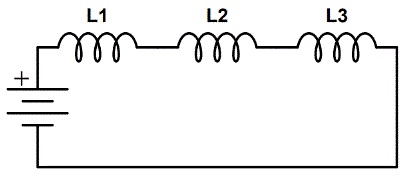Inductors in Series Calculator
Understanding Inductors in Series

When inductors are connected in series, the total inductance is the sum of the individual inductances, provided there is no mutual inductance between them.
Formula:
\( L_{\text{total}} = L_1 + L_2 + \ldots + L_n \)
The total inductance of a series configuration is always greater than the largest individual inductance in the group.
Key Points to Remember:
- The total inductance in a series connection increases with each added inductor.
- All inductors in series share the same current, but their voltage drops differ depending on their inductance values.
- Series inductors are commonly used to achieve a desired inductance value that may not be available as a single component.
Example Calculations
Example 1:
Given:
\( L_1 = 10 \, \text{mH}, L_2 = 20 \, \text{mH}, L_3 = 30 \, \text{mH} \)
Calculation:
- Convert all inductances to Henries:
\[L_1 = 0.01 \, \text{H}, \, L_2 = 0.02 \, \text{H}, \, L_3 = 0.03 \, \text{H}\] - Apply the formula:
\[L_{\text{total}} = L_1 + L_2 + L_3 = 0.01 + 0.02 + 0.03 = 0.06 \, \text{H}\] - Convert back to millihenries:
\[L_{\text{total}} = 0.06 \times 1000 = 60 \, \text{mH}\]
Result:
\( L_{\text{total}} = 60 \, \text{mH} \)
Example 2:
Given:
\( L_1 = 50 \, \mu\text{H}, L_2 = 100 \, \mu\text{H} \)
Calculation:
- Convert all inductances to Henries:
\[L_1 = 50 \times 10^{-6} \, \text{H}, \, L_2 = 100 \times 10^{-6} \, \text{H}\] - Apply the formula:
\[L_{\text{total}} = L_1 + L_2 = 50 \times 10^{-6} + 100 \times 10^{-6} = 150 \times 10^{-6} \, \text{H}\] - Convert back to microhenries:
\[L_{\text{total}} = 150 \, \mu\text{H}\]
Result:
\( L_{\text{total}} = 150 \, \mu\text{H} \)
